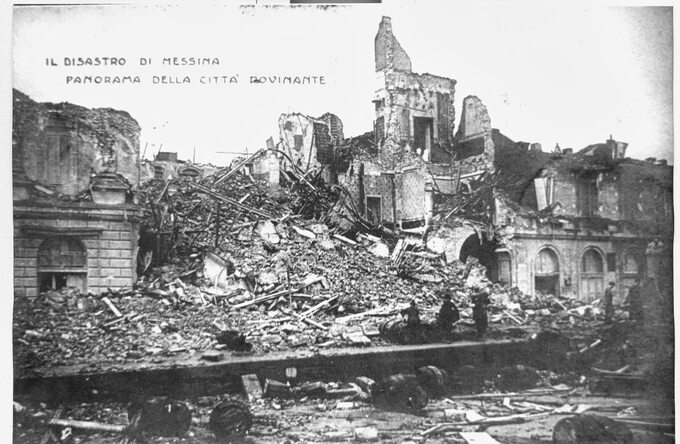The Messina earthquake and subsequent tsunami that occurred on December 28, 1908 destroyed almost the entire city. One of the few surviving buildings was the 12th-century church Santissima Annunziata dei Catalani.
The earthquake of 1908 caused the greatest destruction in Messina and the city of Reggio Calabria in Sicily, although other cities and partially all of southern Italy were affected. The epicenter was in the Strait of Messina, which separates Sicily from mainland Italy. About 100,000 people died as a result of the cataclysm. It was the most destructive earthquake in Europe.
Earthquake in Messina and Reggio di Calabria
Seismic activity in southern Italy was recorded in early November 1908. On December 10, a magnitude 4 earthquake damaged several buildings in Novara di Sicilia and Montalbano Elicona in the province of Messina. In total, from December 1908 to March 1909, more than 290 earthquakes occurred.
The most devastating earthquake was the one that occurred on the morning of December 28, 1908 in the Strait of Messina. It all started at 5:20:27 a.m., a time when most people were in their homes. Although the earthquake lasted only 37 seconds, it reduced two cities to rubble. A tsunami caused by the earthquake (or underwater landslide) that occurred a few minutes later completed the destruction. The magnitude of the earthquake was 7.1 on the Richter scale. Its epicenter was in the Strait of Messina, in the northern part of the Ionian Sea, near the narrowest part of the strait. Tremors were felt in an area of 4.3 thousand square kilometers.
Ten minutes after the earthquake, the sea on both sides of the strait suddenly receded. After a while, twelve-meter waves hit the beach. To this day, the people of Messina claim that the shock wave was so powerful that the statue of Neptune on the beach was moved several meters and turned 180 degrees so that it now faces the sea. The first wave was followed by the second and third waves. The ships in the ports were hijacked and everyone died on the docks. The tsunami wave caused damage as far as Malta.
“Dante's Inferno Was Nothing”
“Dante's Inferno is nothing compared to what we have seen. “Messina today is a city of death,” wrote one of the Italian journalists who reached the ruined city on January 1, 1909.
In Messina, 91 percent of buildings were destroyed or damaged beyond repair. The historic medieval church Santissima Annunziata dei Catalani miraculously escaped the disaster, although it was also damaged, losing, among other things, its baroque decorations. Messina's coastline has been irreversibly altered as much of the coastline has collapsed into the sea. Similar massive destruction occurred in Regio di Calabria.

About 75,000 people died in Messina itself (or half of all the inhabitants), and 25,000 in Reggio di Calabria, on the other side of the Strait of Messina. Such a large number of victims was due to the fact that most people were at home in their beds. During the earthquake, these people were buried under the collapsed walls of their houses.
Survivors later recalled that during the 37-second earthquake, three separate movements of the earth occurred: the first shock felt like it was moving backwards and forwards, the second strongly lifted the ground upwards, and the third moved in a circular motion. . The sound of the earthquake was terrifying, reminding some of the “hissing of red-hot iron in water” or a train speeding through a tunnel.
Hospitals in the region were completely destroyed or severely damaged. In addition, many doctors and nurses were killed. Local politicians, soldiers and policemen died, so they had to wait for their rescue – the relevant services had to come from other cities, which was also not easy, because the roads and railway tracks were damaged. The tragedy of Messina ended with the collapse of the local prison, from which many prisoners escaped. There were searches of ruined buildings, looting, rape and even looting of corpses. An army was sent to Messina to control the situation. The cities affected by the tragedy were saved by sailors from warships flying the flags of Italy, Britain, France, America and Russia. Ships and ships carried the wounded and homeless aboard and delivered food and medicine to the city. Two days after the earthquake, King Victor Emmanuel III and his wife arrived in Messina.
The search for missing persons lasted several weeks. In the days following the earthquake, people were still being pulled alive from the ruins.
Historical buildings were irretrievably lost. During the reconstruction, the layout of the city was changed, the streets were widened and the houses were more earthquake resistant. Only a few buildings survived the earthquake and were in good condition. These include: the medieval church of Santissima Annunziata dei Catalani, the Gothic church of Santa Maria Alemanna, the Byzantine church of San Tommaso Apostolo il Vecchio, the lighthouse of San Ranieri and the Fountain of Neptune by Giovanni Montorsoli.
After the earthquake, many homeless residents of Messina and the surrounding area were relocated to Sicily and other regions of mainland Italy. Many natives of Messina also decided to emigrate to the United States.
The city was not so lucky. Many of the buildings rebuilt or erected after the 1908 earthquake were destroyed by bombing during World War II. Messina is sometimes called “the city without memory”, but despite these losses, you can still see remnants of its former glory.
Also read:
Tsunami in Darlovo. The height of the waves was up to 20 metersAlso read:
Big water in Wroclaw. How did they fight the Millennium Flood 26 years ago?Also read:
10 largest and most tragic earthquakes in the history of the world
(translate tags)Messina
